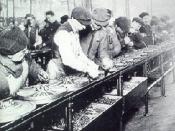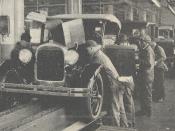When the new black Model-T came off the assembly line and started in Ford's plant in Highland Park (Detroit) 90 years ago, the human industrial society began to change. Looking the same as any previous models, this Model-T was built only in one and a half hours. The saved ninety percent of labour hour rapidly led to 'The First Industrial Divide' of the western world. Even today, how deeply this industrial revolution, the so-called Fordism, had actually affected our society is still a controversial topic. In what following, an analysis of Fordism and Post-Fordism will be conducted concerning both current and historical examples as well as some classical arguments, in order to identify the society we are living in.
When referring to the term Fordism, the frame of monotonous and simple jobs, standardized single products, intense industrial relations will occur immediately. One comprehensive definition given by Michel Aglietta (1979) is the 'regime of accumulation involving specific forms of capitalist production as well as social consumption norms.'
According to Robin Murray (1989) (Cited by Madry and Kirby, 1996, pp.50), the Fordist production was based on four major principles, which are standardization, mechanization, scientific management and flowline production.
These Fordist production principles largely raise the firms' productive efficiency and then increase the productivity of the whole economy. Specifically, standardization can save time and resources in developing different types of parts to match different types of products; mechanization saves the labour cost and increases some workers' safety; Scientific management, which is heavily influenced by Taylorism, refers to both fragmented tasks and redesigned jobs based on Time-and-Motion studies, i.e. break tasks into simplest pieces and strictly manage the production process to stop workers from being lazy; The flowline, compared with nodal assembly, not only saves the moving time for workers but also helps...


